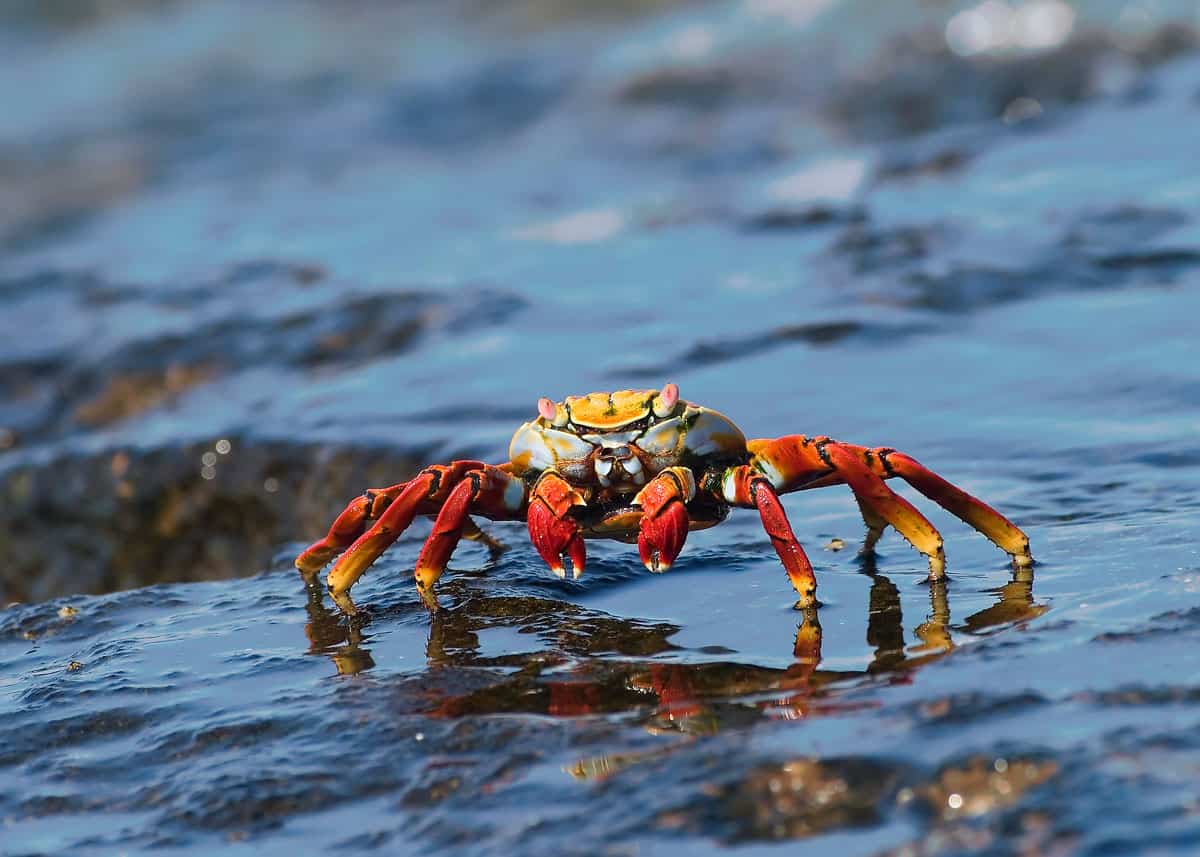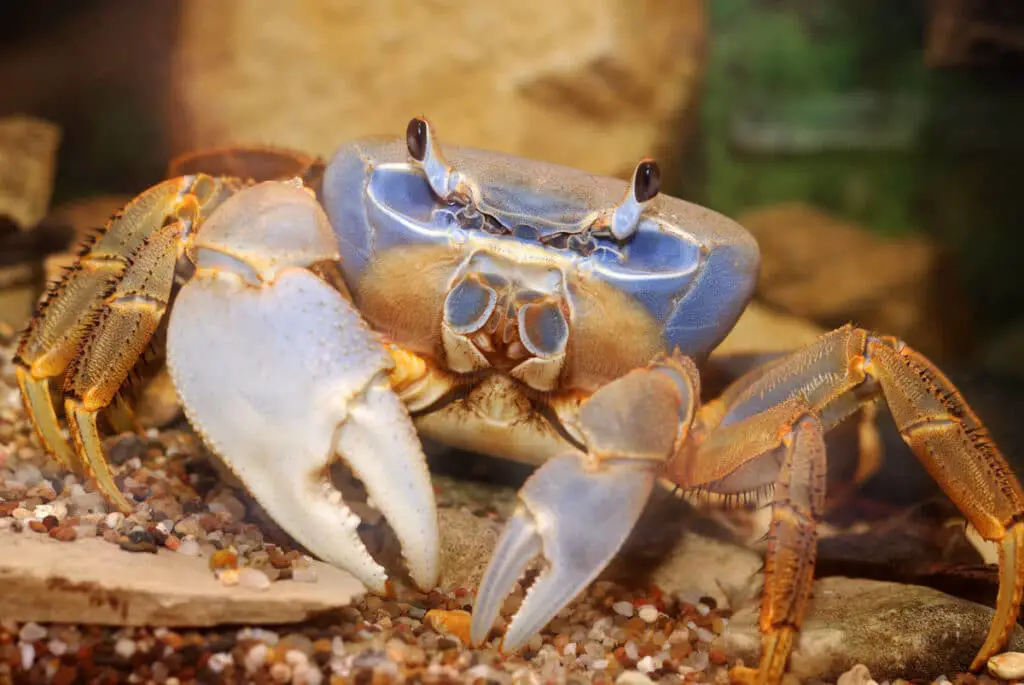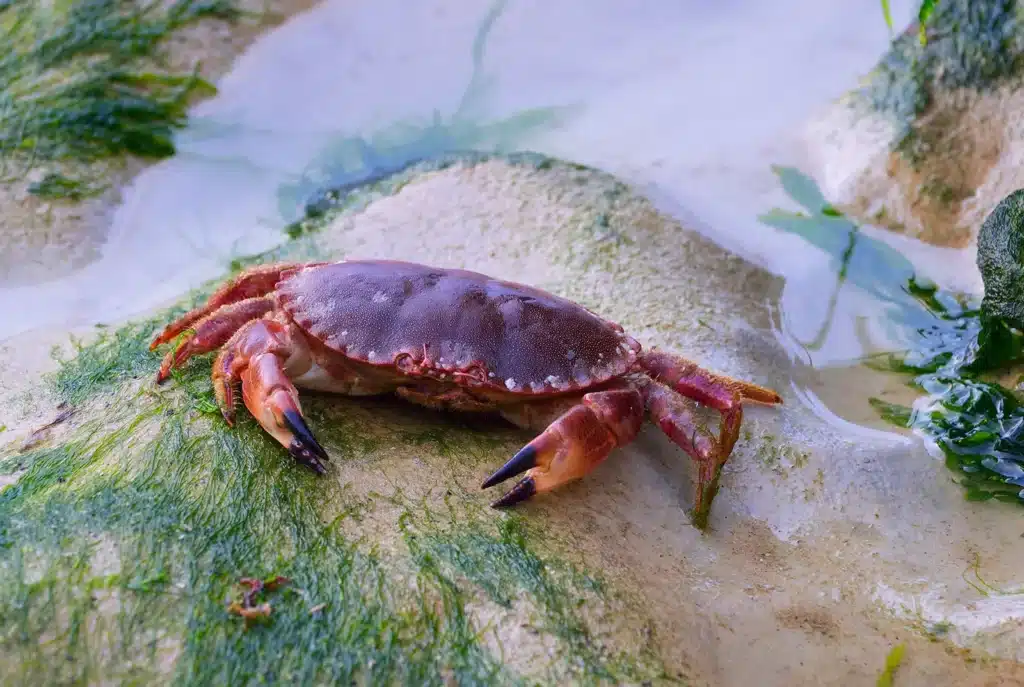Are Crabs Omnivores

Introduction
Are Crabs Omnivores: Crabs, those captivating crustaceans populating the world’s oceans, often spark curiosity regarding their dietary habits. In our exploration of crabs and their culinary inclinations, This query unveils the fascinating diversity in the feeding behaviors of these remarkable creatures and reveals their adaptability to a wide array of marine and aquatic environments.
Crabs, belonging to the order Decapoda, encompass a multitude of species, each with its unique ecological niche. While the label “omnivore” generally characterizes crabs as having diets that incorporate both animal and plant matter, the specifics of their dietary preferences can differ significantly based on factors such as their habitat, size, and species.
Many crab species indeed exhibit omnivorous tendencies, displaying a remarkable flexibility in their food choices. Their diets encompass an extensive range of food sources, from small fish, mollusks, worms, and plankton to algae, seagrass, and detritus. This adaptability enables them to thrive in a wide spectrum of marine and aquatic ecosystems, contributing to the intricate web of life beneath the waves.
Yet, the world of crabs also hosts herbivorous and carnivorous species, adding complexity to the classification of crabs as omnivores. In our exploration, we will delve into the various feeding strategies employed by crabs, shedding light on the diversity of their culinary preferences and their vital roles in marine ecosystems.

Are all crabs omnivores?
Like many other crustaceans, crabs are often omnivorous and act as scavengers, but many are predatory and some are vegetarian.
While many crab species exhibit omnivorous tendencies, their dietary preferences can vary widely based on factors such as their habitat, size, and ecological niche. Crabs belong to a diverse group of crustaceans, and their feeding habits are adapted to suit their specific environments.
Some crabs are primarily carnivorous, preying on smaller marine organisms like fish, mollusks, worms, and even other crabs. These carnivorous crabs are equipped with strong claws and sharp pincers that are well-suited for capturing and consuming animal prey.
On the other hand, there are herbivorous crab species that primarily feed on plant material, such as algae, seagrass, and decaying plant matter. These crabs use specialized mouthparts to graze on vegetation and are essential in controlling algal growth and participating in nutrient cycling within their ecosystems.
Additionally, there are crabs with more varied diets, including detritivores that primarily consume decaying organic matter, filter feeders that capture plankton and particles from the water, and scavengers that feed on carrion and dead organisms.
Crabs display a wide range of dietary habits, and their classification as omnivores, carnivores, herbivores, or other feeding strategies depends on their species and the ecological roles they play within their habitats.
Is crab a carnivore or omnivore?
Crabs are omnivores, feeding primarily on algae, and taking any other food, including molluscs, worms, other crustaceans, fungi, bacteria, and detritus, depending on their availability and the crab species. For many crabs, a mixed diet of plant and animal matter results in the fastest growth and greatest fitness.
Crabs can exhibit a range of dietary preferences, and their classification as carnivores or omnivores depends on the specific species and the available food sources in their environment.
Many crab species are considered omnivores, which means they have a varied diet that includes both animal and plant material. They are opportunistic feeders, adapting their eating habits to what is readily available in their habitat. These omnivorous crabs consume a diverse array of foods, such as small fish, mollusks, worms, plankton, algae, seagrass, and detritus. Their flexibility in diet allows them to thrive in a wide range of marine and aquatic ecosystems.
However, it’s important to note that not all crabs are strict omnivores. Some crab species are primarily carnivorous, with a diet that predominantly consists of animal matter. These carnivorous crabs have specialized adaptations, including powerful claws and sharp pincers, for capturing and consuming prey like fish, crustaceans, and other small marine organisms.
On the other hand, herbivorous crabs primarily feed on plant material, including algae, seagrass, and decaying vegetation. They play crucial roles in controlling algal growth and nutrient cycling in their habitats.
While many crabs are omnivores with diverse diets, there are also carnivorous and herbivorous crab species, illustrating the adaptability and ecological diversity within this group of crustaceans.
Are coconut crabs omnivores?
Coconut crabs are omnivorous scavengers who’s diet consists of a wide variety of items. Their highly developed sense of smell helps them scope out potential food sources; Anything from their namesake coconuts to plant debris, tropical fruit, carrion… Even their own molts!
Coconut crabs (Birgus latro), the largest terrestrial arthropods on Earth, are primarily omnivores, but they also display some herbivorous tendencies. Their diet varies based on what is available in their tropical island habitats.
As omnivores, coconut crabs are opportunistic feeders. They have been observed consuming a wide range of foods, including fallen fruits, coconuts (from which they get their name), nuts, leaves, carrion, small vertebrates like birds and rats, and even other coconut crabs. They are skilled climbers and can ascend coconut trees to access their fruit, which they then crack open with their powerful claws.
Coconut crabs also exhibit herbivorous behavior, as they consume plant material such as leaves, flowers, and fibrous husks. They are known to feed on the pulpy interior of coconuts, although their preference for ripe and fallen coconuts indicates a scavenging behavior rather than actively hunting the fruit.
This varied diet makes coconut crabs vital to their island ecosystems as both consumers and scavengers. They play a role in seed dispersal, nutrient cycling, and the recycling of organic matter. While they are considered omnivores, the availability of different food sources in their habitats influences the balance between their carnivorous and herbivorous behaviors.
Is green crab omnivore or carnivore?
Omnivores
Green crabs are omnivores, eating both plants and animals. Their prey include bivalve shell- fish, juvenile lobsters, other green crabs, periwinkles and juvenile winter flounder, as well as other small fish (Taylor 2005).
The green crab (Carcinus maenas) is often classified as an omnivore, although its feeding habits can vary depending on its life stage and the availability of food sources in its habitat.
As juvenile green crabs, they tend to be more carnivorous, primarily feeding on small invertebrates, mollusks, and crustaceans. They are known for their voracious appetites and can have detrimental impacts on local bivalve populations, which has led to concerns in regions where they have become invasive.
However, as green crabs mature, they tend to adopt a more varied diet, incorporating plant material such as algae, seagrass, and detritus into their meals. They become opportunistic feeders, adjusting their diets based on the season and the abundance of different food sources.
Their omnivorous nature allows green crabs to adapt to various environmental conditions and food availability in their coastal and estuarine habitats. This adaptability can be advantageous for their survival, as they can switch between animal and plant matter depending on what is most accessible.
While green crabs are often considered omnivores, their feeding habits can change as they grow, making them versatile consumers with the ability to adapt to their ever-changing surroundings.
Are king crabs omnivores?
Red king crabs are omnivorous and will eat just about any dead or decaying organic matter (plant or animal) and a variety of invertebrates. Like in all decapods, the red king crab’s shell really is a skeleton on the outside of its body.
King crabs, particularly those of the family Lithodidae, are predominantly carnivorous. Their diet primarily consists of animal matter, and they are known for their predatory behavior, feeding on a variety of marine organisms. King crabs have powerful claws and spiky appendages that are well-suited for capturing and crushing their prey, which often includes smaller invertebrates, mollusks, worms, and even other crabs.
While king crabs are largely carnivorous, they may also exhibit some opportunistic omnivorous behavior. In addition to their meat-based diet, they have been observed consuming detritus, algae, and plant material on occasion. However, these instances of herbivory or omnivory are relatively rare compared to their carnivorous activities.
King crabs are typically found in cold ocean waters, particularly in the Northern Pacific and the Antarctic, where they inhabit deep-sea ecosystems. Their predatory nature and ability to consume a wide range of prey make them important members of these marine food webs, helping to control populations of various organisms.
King crabs are primarily carnivores, with their diet mainly consisting of animal matter. While they may occasionally consume plant material or detritus, their role as predators in their ecosystems is of greater significance.
Are there herbivorous and carnivorous crabs as well?
There are both herbivorous and carnivorous crabs, and their dietary preferences vary widely based on their species, habitat, and ecological niche.
Carnivorous crabs are those primarily focused on consuming animal matter. They have specialized adaptations such as strong claws and sharp pincers for capturing and consuming prey. These crabs feed on a variety of marine organisms, including small fish, mollusks, worms, crustaceans, and even other crabs. Examples of carnivorous crabs include king crabs and Dungeness crabs.
Herbivorous crabs, on the other hand, primarily feed on plant material. They may graze on algae, seagrass, and decaying plant matter. Herbivorous crabs are particularly important in controlling algal growth and participating in nutrient cycling within their ecosystems. Species like marsh fiddler crabs and Sally Lightfoot crabs exhibit herbivorous behavior.
There are omnivorous crabs that have a varied diet, including both animal and plant material. These crabs are opportunistic feeders, adapting their diet based on the availability of food sources in their environment. Green crabs and coconut crabs are examples of omnivorous crabs.
The diverse dietary habits of crabs reflect their adaptability and ecological roles within marine and aquatic ecosystems. They contribute to nutrient cycling, prey regulation, and overall ecosystem health.
What do omnivorous crabs typically eat in their natural habitats?
Omnivorous crabs are opportunistic feeders with versatile diets that adapt to the food sources available in their natural habitats. Their omnivorous nature allows them to consume a wide variety of both animal and plant matter, making them adaptable and successful in various ecological niches.
In marine environments, omnivorous crabs often feed on small invertebrates like worms, small mollusks, and crustaceans. They may also prey on planktonic organisms, such as tiny marine animals and larvae, which they capture using their specialized appendages.
These crabs readily scavenge carrion and dead organisms when the opportunity arises, helping to recycle nutrients in their ecosystems. They can also consume detritus, which consists of decomposing organic matter, including dead plants and animals.
Omnivorous crabs may incorporate algae and seagrass into their diets, especially when animal prey is scarce. They graze on algae growing on rocks, seafloor surfaces, or submerged vegetation. Some omnivorous species, like green crabs, can consume plant material, making them particularly adaptable to a variety of coastal habitats.
Overall, the diet of omnivorous crabs is diverse and adaptable, allowing them to exploit various food sources based on seasonal changes and the availability of prey and plants in their natural habitats. This flexibility contributes to their ecological success and role in nutrient cycling in marine and aquatic ecosystems.
How do crabs’ dietary preferences vary based on their habitat and ecological niche?
Crabs’ dietary preferences are strongly influenced by their habitat and ecological niche, resulting in variations in their feeding behaviors:
- Marine Environments: Crabs inhabiting rocky intertidal zones or seafloor areas often have diverse diets. They may consume algae, small fish, mollusks, and other crustaceans. Those in deeper marine environments may prey on bottom-dwelling organisms.
- Estuaries and Mangroves: Crabs in estuarine regions often have access to both marine and freshwater resources. They may feed on detritus, small invertebrates, and aquatic plants, adapting to the fluctuating salinity and food availability.
- Salt Marshes: Crabs in salt marshes tend to be detritivores and herbivores. They feed on decaying plant matter, algae, and detritus, playing critical roles in nutrient cycling within these ecosystems.
- Coral Reefs: Coral reef-dwelling crabs may have specialized diets, such as grazing on algae, scavenging on coral polyps, or consuming planktonic organisms. Some are predators preying on smaller reef inhabitants.
- Deep-Sea: Crabs living in deep-sea environments have adapted to scarce food resources. They often feed on detritus, small organisms that drift down from the surface, and may exhibit opportunistic predatory behavior when larger prey is available.
- Terrestrial: Terrestrial crabs like coconut crabs may consume a variety of foods, including fruits, nuts, carrion, and even small vertebrates. Their diet can change depending on the availability of terrestrial resources.
These variations in dietary preferences demonstrate crabs’ remarkable adaptability to their specific habitats and ecological roles. Their ability to exploit diverse food sources contributes to their success in a wide range of environments, and they play essential roles in the functioning and balance of their respective ecosystems.

Conclusion
The classification of crabs as omnivores provides only a partial glimpse into the rich tapestry of their dietary preferences and ecological roles. While the label “omnivore” broadly characterizes crabs as having adaptable diets encompassing both animal and plant matter, our exploration has revealed the intricate nuances that define their feeding behaviors and ecological significance.
Crabs, as diverse as the ecosystems they inhabit, showcase remarkable adaptability in their culinary choices. Their ability to shift their diets based on the availability of food sources in their respective habitats underscores their evolutionary prowess. Some crabs are indeed true omnivores, exploiting a wide array of food items, while others specialize as carnivores, preying on smaller marine organisms, or as herbivores, primarily grazing on algae and plant material.
These varied feeding strategies are essential components of marine and aquatic ecosystems. Crabs play vital roles in nutrient cycling, prey regulation, and the maintenance of ecological balance. Their presence is crucial for the health and resilience of these environments, making them indispensable contributors to the intricate web of life beneath the ocean’s surface.
In our quest to understand crabs and their dietary preferences, we have unearthed the complexity of their ecological roles and the vital interconnections they forge within the aquatic world. The label of “omnivore” only scratches the surface of their multifaceted nature, underscoring the need for continued exploration and appreciation of these remarkable crustaceans and their intricate relationships with their environments.



